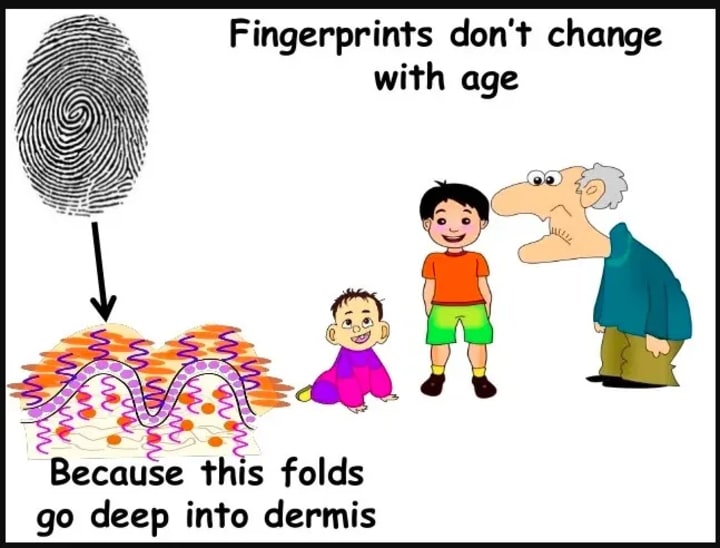Human Fingerprints
Unique Stamp of Nature (Part-1)

Every person is unique, like a fingerprint. No two minds are the same, just like no two snowflakes are alike.
Since the beginning of time, scientists, forensic experts, and curious people have been fascinated by the patterns on our fingers. Fingerprints, which are nature’s unique stamp, are charming. Even though fingerprints seem simple, there are many amazing things about them. In this piece, we’ll look at some interesting facts about fingerprints backed up by science. We’ll discover the secrets behind the unique ridges that make each of us distinctive.
Unique Identifiers
Did you know that your fingerprints are like snowflakes? They are all different, and no one else has the same ones. Even twins who are precisely alike can’t share the same fingerprints. Can you believe there is only a 1 in 64 billion chance that two people have the same fingerprints? What a lucky person you are!
Formation in the Womb
Did you know fingerprints originate in the womb? In reality! These traits begin in the tenth week of pregnancy. I can’t believe our bodies are generating these tiny details before birth. The world’s miracles surprise me daily. They develop in the womb due to an incredible interaction between genes and the early developmental position of the fetus. A fingerprint’s fascinating history is remarkable.
Permanence over Time
Did you know that fingerprints are one of the few physical features that remain constant throughout a person’s lifetime? I cannot believe it.

Three Main Types of Ridges
Fingerprints are an attractive subject due to their composition of distinct ridges. Three different shapes can be seen in their formations, including spirals, arcs, and loops. It’s interesting to note that more than half of all fingerprint patterns contain loops. Arches and whorls were the following motifs to appear. The level of organization in this situation is indeed impressive.

Fingerprint Patterns Are Inherited
A combination of genetic and environmental factors determines the unique patterns of your fingerprints. Although the internal environment during prenatal growth can vary the development of fingerprints, the overall types of fingerprint patterns are inherited from parents. Multiple genes control them. The complex interaction of different genes produces this unique pattern.
Fingerprints aren’t Just on Your Fingers
These unique designs are also present on our feet' palms, toes, and soles. Fingerprints, unique patterns found throughout the body, are tiny in size and serve as a distinctive identifier for individuals.
Fingerprints for Grip and Sensation
Fingerprints have a more significant role in our daily lives than just identification. They are essential for our ability to appreciate and secure the objects we hold. Our skin's unique ridges and valleys allow us to grip things effectively. While this tactile function often escapes notice, it helps to create friction between the object and our fingers. With fingerprints, maintaining a confident hold on the things we value would be easier.
Development of Fingerprint Analysis
Sir Francis Galton started dactyloscopy, the study of fingerprints, in the late 1800s. This person significantly contributed to the development of modern forensic fingerprint analysis, which is now commonly used to solve criminal cases.
Are the fingerprints of one person for both hands the same?
No, the fingerprints on each of your fingers are not the same.

The fingerprints on each finger and palm are distinct and unique to that specific part of the hand. While there are similarities in the overall patterns, such as loops, whorls, or arches, the precise arrangement of ridges and minutiae points (small ridge details like endings, bifurcations, and dots) is different for each finger and palm.
Let’s explore some everyday examples that highlight the significance of fingerprints in our lives:
Smartphones and Biometric Security:
Most smartphones now have a fingerprint sensor that can be used to open the phone or make purchases. This method uses the fact that everyone’s fingerprints are different to give quick, safe access to personal data.
Airport Security and Passport Control:
Fingerprint scans are a regular practice at immigration controls. This biometric identification lowers the risk of identity theft and fake passport applications.

Criminal Investigations and CSI Shows:
In popular crime series like CSI, fingerprint evidence is regularly used to identify suspects and solve cases positively. While fingerprints aren’t nearly as necessary to solve crimes as they are on television, forensic science is routinely used.
Access Control in Offices:
Fingerprint readers are widely used in modern businesses to control who can get into restricted areas. Management can do more to protect the security of private data and resources by making workers put their fingers on a scanner when they enter the building.
Home Security and Locks:
Some locks and protection systems let you use your fingerprints to prove who you are. This makes things easier and helps make sure that only authorized people can get into a home or other protected place.
Child Identification Programs:
Some communities offer child identification programs that record a child’s fingerprints and other essential information. If police access this data, they can locate a missing child significantly quicker.
Cashless Transactions and ATMs:
Biometric identification, like scanning fingerprints, is becoming more common in the banking business. This feature provides an extra layer of protection, making cashless transactions and ATM withdrawals secure.
Art and Creativity:
Fingerprints are no longer just used for science and security. They are now a unique and creative way for artists to show themselves. Fingerprints have become famous in many kinds of art, such as fingerprint painting and personalized greeting cards.
DIY Science Experiments:
Fingerprinting is widely used in exciting science experiments. These involve children in a hands-on activity that explores fingerprints' uniqueness and introduces them to the basic principles of forensic science.
Parenting and Baby Books:

Parents who want to preserve their children's memories forever often include their footprints and fingerprints in baby books or keep them as personal treasures. Tiny prints are a beautiful way to protect and treasure the special moments of a child’s early years.
Using fingerprints in our daily lives makes us safer and more convenient, and it also shows how important they are as a part of our identity. They can unlock our phones, let us move internationally, and even help us connect with loved ones by holding hands.
____________________________________________________
Initially published on Medium by the author.
If you enjoy my story, I'd love to hear from you! 😊 Drop a comment sharing what you liked or what caught your interest. 💬 Your likes, shown as ❤️ hearts, keep me motivated to share my writing with you. If you feel like it, you can also give a small tip 💰, which goes towards helping students who struggle with education costs. 📚 I'm grateful for your support. 🙏 So, by joining in, you're supporting me and helping others get the education they deserve. 🌟
Thanks for reading!
With best regards
Ameer Bibi
About the Creator
Ameer Bibi
I love to read, write, and discuss life, health, fiction, and humour. If you write anything related to these topics, subscribe to me and share your story; I would love to read it and share my opinion. You can find me on Medium.
With Thanks
Reader insights
Nice work
Very well written. Keep up the good work!
Top insight
Expert insights and opinions
Arguments were carefully researched and presented






Comments (5)
What a unique and intriguiging story to focus on! Our anatomy and physiology truly is fascinating. I learned a few things that I didn't know and this was such an engaging and informative read. Thank you for writing and sharing!
Great read, Ameer
Amazing!
Ameer, thank you for your diligent research into this topic. Not only that, but you did a beautiful job of simplifying the contents and putting all into a simple, easy to read format! Well done!
Amazing congratulations, can you read mine also?